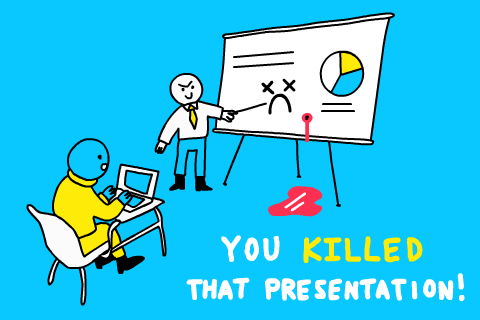It’s not a presentation. It’s a performance.
Early in my career, I struggled to create compelling presentations. A simple shift in my mindset, along with few techniques to refine my approach, helped me up my prezo game significantly.
Early in my career, I struggled to create compelling presentations. Looking back, there were two misconceptions held me back:
1. Presentations weren’t really that important (“good work speaks for itself”)
2. You’re either naturally good at presenting—or you’re not.
In terms of #2, I definitely saw myself in that latter category. Yet, interestingly, I had no problem telling captivating stories to friends (or at least I thought so!). In my mind, though, that felt like an entirely different skill set.
But here’s the thing: everyone recognizes a good story when they hear one, and those same storytelling elements—an engaging beginning, a satisfying peak, and a clear resolution—can transform any presentation into a memorable performance.
From Slides to Storytelling
When starting to plan out your presentation, instead of getting bogged down by what slides you need to create, focus on the story you want to tell and how you’ll perform it in front of your audience. It’s easy to get stuck at this step, but with the help of generative AI tools like ChatGPT and Claude (my go-tos), you can quickly get over this hump.
Getting into the details of the AI prompts is beyond the scope of this article, but if you want to learn more, check out the section under 15 Best AI Presentation Prompt Examples in 2025 in the linked article.
Good storytelling doesn’t happen by chance - it takes plenty of practice! This is A good segue to the next point.
A study cited in the Harvard Business Review shows that narratives are significantly more memorable and persuasive than plain facts alone—some say up to 22 times more memorable. So it’s worth investing in this skill.
Practice in Chaos
Ask yourself: Would your presentation hold someone’s attention in a noisy environment?
While you’ll likely present in a quiet room, people can still be easily distracted by phones, side conversations, or simply their own thoughts.
A great way to practice your presentation is to recruit a friend or a colleague to be your audience, and give your presentation in a busy park, a noisy bar, or anywhere filled with distractions. Then, ask your practice audience what they remember most. If it’s not what you intended, you’ll want to refine your content. Two main benefits you'll get from this is that you'll likely have better content, and you'll feel much more confident walking into a quiet conference room.
By the time you step into a quiet conference room, you’ll be ready to captivate even the most restless listeners.
Simplify the Details, Exaggerate the Key Points
Being an active listener is hard work. Your audience has to juggle a lot details in their heads at once. Unlike reading an article or watching a pre-recorded video, they can’t rewind your live talk. To help them follow along:
Trim unnecessary details and avoid heavy business jargon.
Use sensory descriptions (smell, sound, touch, taste) for a more immersive effect.
Exaggerate or emphasize crucial points to make them truly stand out.
When you simplify what’s unnecessary, your audience can better focus on what really matters.
Warm Up Before You Speak
Just like you’d warm up before a workout, a quick warm up routine before a presentation can work wonders for your energy, confidence, and overall delivery. A few light stretches and vocal exercises can loosen you up and help you start strong. Remember, those opening lines set the tone for everything that follows.
If you need ideas, check out Top 10 Public Speaking Warm-Ups to Keep You Calm and Focused Before A Presentation. If you find yourself feeling silly doing something like this, know that I did too! Pro tip: GET OVER IT! I can tell you from first-hand experience it makes a huge difference.
Close with a Strong Ending
We’re wired for clear resolutions to a story, and your presentation is no different. A weak ending can drag down the entire thing. Remember, the main reason you gave the presentation in the first place is to persuade your audience of something. Using the ending to sum up your main points, remind everyone why your presentation matters, and encourage them to take a specific action or adopt a new perspective.
Measuring Your Success
As a consultant, I pay attention to what I jokingly call my “Persuasion Conversion Rate,” or PCVR (a term I coined, but you get the point 🤣). One KPI I use is the kind of questions I get at the end of a presentation. If people are asking about things I’ve already covered, that’s a sign I need to articulate my points more clearly.
Bringing It All Together
While I’m not claiming to be one of the best storytellers out there, I have found that ’ve gotten much better using these techniques. And a big part of it was shifting my mindset from what specific slides I was going to create to what is a compelling story I can tell.
By practicing in challenging environments, warming up effectively, and focusing on immersive storytelling techniques, you can elevate your presentation game up as well.
Remember, it’s not just about delivering information—it’s about creating a performance that people will remember.




